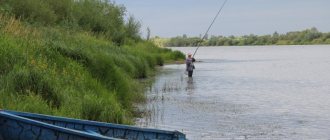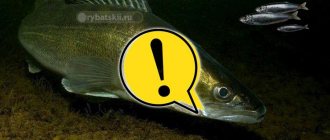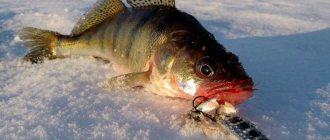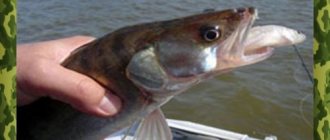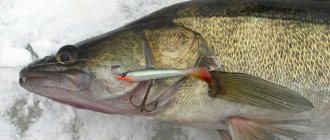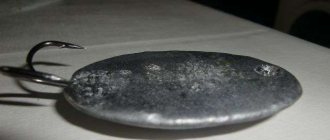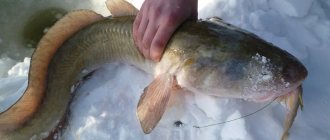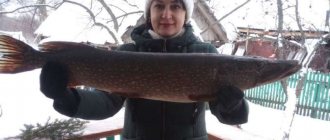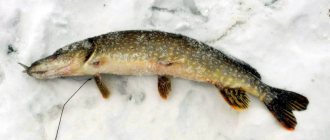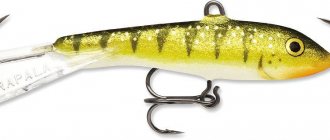Catching pike perch even in the middle of winter is no less interesting and exciting than at other times of the year. Of particular interest in winter fishing is fishing for pike perch using girders, but not all fishermen can boast of successful experience in such fishing. In practice, catching this predator does not require any special skills. It is important to know the lifestyle of the toothy predator during this period and some of its habits. One of the basic criteria for the success of fishing for pike perch in winter is to choose the right place and guess the time of day.
Fishing for zander in winter
Winter rigs for pike perch come in different designs:
- vertical;
- horizontal;
- changelings;
- under the ice;
- on a leg.
If the water in the reservoir is stagnant, the classic option is more preferable. When fishing on a river with a current, it is better to use vertical girders with the ability to fish in the dead of winter and ease of installation in prepared holes.
The greatest activity of pike perch is observed when the water in the river is completely frozen and at night. This is the ideal time to place the girders. The process itself is not complicated, but unique. The fanged fish is always cautious, but does not stop feeding in winter.
Prefers to be found near concentrations of forage fish.
Food supply for pike perch is one of the conditions for successful fishing. The best bait is live: perch, headfish, roach. Although in a strong current, dead small fish (sprat, sprat) are also quite suitable, when strong currents can stir it up in the stream of water.
Live bait
If you find the right point, you can successfully catch striped fish even in the dead of winter. The fanged one cannot resist the fish scurrying under his nose. In winter, pike perch takes live bait even when all artificial baits are silent. But for this you need the right live bait.
The pike perch has a narrow throat and feeds on narrow-bodied fish. When fishing with girders, you need to use the types of fish that the predator feeds on in that particular body of water. In winter, pike perch may not react to live bait from a store (or other body of water). In general, searching for live bait in winter to bait pike perch is a headache for the garrison. This is exactly the difficulty that pushes some anglers away from winter fishing. Options for solving it:
- Catching pike perch in winter with bleak, verkhovka (everywhere), sprat (in the Volga basin), smelt (in the North and Baltic) caught with a fishing rod or lift in advance (even from another body of water).
- Buying live bait at a fishing store.
- Parallel fishing for live bait with a fishing rod, while waiting for a bite on the girder. When fishing in the right place, this is quite simple - in winter, pike perch always stands next to concentrations of forage fish.
In any case, when organizing regular fishing trips for pike perch on girders in winter, you need to worry about it in advance and organize the availability of live bait. For cold storage, a special can is used. The main condition is live fish. It is live bait that is the main factor in attracting fanged fish in winter.
Minnow, dace, chub, and roach are also suitable as live bait in winter. Striped catches perch and ruff (in some reservoirs). The favorite baitfish of pike perch is gudgeon. The pike perch will certainly not bypass him. But it is not always possible to get or catch a gudgeon in winter and not everywhere.
When fishing in strong currents, you can use dead sprat or sprat (or frozen ones from the store). A strong stream will move even a dead fish in its stream. But this method is more suitable for winter fishing with a jig or a special pike perch rig for sprat, since the movement of the bait by the current may not be enough - you need to constantly twitch and pull the rig. However, in some reservoirs, baits for pike perch on sprat work well in winter, and local fishermen take advantage of this without bothering with finding and storing live bait.

Tulka
Pike perch on zherlitsy in winter on sprat
Tulka is one of the main, favorite baits for catching pike perch on girders in winter. Today, thanks to the improvement of the environmental situation, the number of juveniles in rivers, lakes, and reservoirs in Russia has increased significantly.
Thus, on the Volga and Oka, when the water flow is strong, you can often observe large accumulations of small, light fish, pressed to the bottom of the river or rolling down near cliffs. Small bait, unable to rise up, becomes available food for hungry predators.
Often it simply rolls into holes, lingering for a certain period of time, which can become a very promising area for fishermen.
You can serve pike perch with sprat for lunch in any form:
- alive;
- dead;
- cut into pieces.
The main thing is to stock up on small bait for future use, so that there is enough for the entire fishing process. Also, place pieces of fish on the hook in a timely manner to feed the pike perch and do not allow the bait to hang down excessively. Why do you need to securely fasten it to avoid being quickly pulled off the hook by a toothy predator?
How to make a girder for pike perch in winter?
When choosing the optimal option for a girder, it is worth considering 3 important points: terrain conditions, time of year, water current.
If the water is running and standing, then it is appropriate to make a classic version of the tackle:
- Wind monofilament fishing line (thickness - 0.35 mm, length - 8-10 m) onto the reel.
- Thread a sliding weight (cone, olive) onto a cord with a weight (1/10 of the mass of the fry) to hold the bait in the desired horizon.
- Install a movable stopper (silicone) just below the sinker with the ability to vary the length of the leash and change its position on the fishing line as necessary.
- Tie a single (double, triple) hook , taking into account the fishing time and the type of live bait. If you intend to catch small and passive fish with a bait through the mouth, then a single hook is suitable. If you hook live bait by the gills, then there is a double option. It is better to hook spiny ruffs on the back, it is better to hook perch on a treble hook.
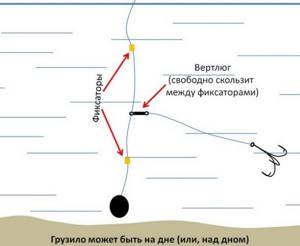
If you plan to fish in the current, then experts recommend tying a paternoster, for which:
- take the main fishing line , make a large 1 m loop at the end;
- cut to obtain ends of 70 and 30 cm;
- tie a sinker to the short end of the fishing line, the weight of which can hold the tackle at the intended fishing point;
- tie the hook to the long end immediately before throwing the tackle into the water.
The main thing is that the do-it-yourself vent looks as natural as possible and does not scare off a predator.
Rigging for pike perch in winter (line, sinker, leash)
Varieties of zherlits for pike perch:
- Horizontal, convenient and taking up little space;
- Vertical with easy transportation and ability to install in deep snow;
- Changelings as simple baits with the possibility of self-production;
- Under the ice in case of spending a long time fishing in severe frosts.
Basic equipment parameters recommended for successful fishing:
- Line (length 5-10 m, thickness - 0.35 mm, diameter - 0.3-0.4 mm) with the ability to supply bait to the most remote, deep points
- Sliding sinker (cone, olive, bullet) threaded on a cord. The weight (1/8 of the mass of the fry) should be sufficient to hold the bait in a free state and at the desired horizon.
- Leash , preferred option: braided, thin monofilament line up to 0.2 mm in diameter.
Pike perch usually do not cut through the fishing line with their teeth, so a metal leader is rarely used. In addition, it can scare away fish.
If there is additional pike in the river and bites are expected, then it is better to install a nylon leash.
As additional equipment when fishing for pike perch, it is advisable to have on hand:
- foam insulated edging for live bait;
- hook for the purpose of pulling large specimens out of the holes;
- yawner for removing hooks from the mouth of pike perch;
- a jar of bloodworms.
Selection and equipment of tackle
Catching pike perch in winter mainly takes place with one rod. However, several sets of gear are needed to scout the area.
To assess the bottom topography and fish activity in a given area of the reservoir, fishermen use several rods, placing the bait at different depths across the edge. By taking turns lifting the fishing rods and letting the bait play, an experienced angler can correctly assess the situation, determine the place of the greatest activity, and begin productive fishing.
Typically, the following gear is used to catch pike perch using sprat:
- vertical lure fishing rod;
- girders;
- suckers.
Let's take a closer look at each type of gear.
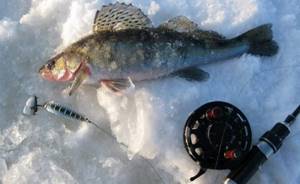
Zherlitsy
For winter fishing, many fishermen prefer to take a fishing rod with a flag, the raising of which signals a bite. The structure is assembled on a tripod, on which a reel with a flexible metal plate and a flag is installed.
The zherlitsa itself is dressed up as follows:
- main line 0.25-0.5 mm;
- leash - fishing line 0.2-0.3 mm;
- line reserve on the reel – 10-20 m;
- hooks – single No. 9-12, double No. 6-7.
Pike perch is a cautious predator, so experienced fishermen prefer a single hook. It is also advised not to rush with the hook, so as not to pull the hook out of the fish’s mouth. However, if you tighten it, the predator may confuse or break the tackle.
Video: rigging a girder for pike perch
Deliveries
The catch is one of the simplest gear that is used to catch predators. Components of the spacer:
- reel;
- monofilament 0.3-0.5 mm;
- sinker (sliding) 4-12 grams;
- sinker stopper;
- leash;
- hook.

Fishing rod
The selection of a fishing rod for pike perch must take into account the habits of the predator and the features of its structure in order to productively hook and pull out fish:
- The fishing rod must be strong and rigid enough. Length – up to 90 cm;
- a fairly large reel with a smooth running, on which you can wind 20-30 meters of fishing line;
- quite a sensitive nod - experienced fishermen use the spring of an old mechanical watch. Such a nod will remain sensitive at any temperature and will not break;
- monofilament line 0.2-0.3 mm with a strength index of at least 3 kg;
Important! Don't use braid. At low temperatures it becomes tough and prone to tangling and knotting.
- sharp hook made of high quality steel.
Jig
Jig fishing is the use of a spinning rod and specific jig gear and jig fishing techniques.
- As a jig rod, choose a fishing rod with fast or ultra-fast action. Its length for winter fishing is no more than 1 meter;
- a reliable inertia-free coil should be used;
- in winter you should use only monofilament fishing line 0.12-0.17 mm;
- two types of sinkers: “Cheburashka” and “jig head”. The second one is easier to use, however, it is prone to snags.

"Cheburashka"
How to put live bait on a hook (by the lip, by the back, what kind of bait are used)?
Pike perch prefers to live in the bottom layers of rivers and cannot resist small fish up to 7 cm in length. Perches, brushes, minnows, gobies, bleaks, and roaches are suitable as live bait. For successful fishing, it is enough to have up to 50 such fish in your arsenal.
Place the hook on the hook in two ways:
- Behind the back , as a preferable option when fishing in still waters. Why: the hook is inserted into the dorsal fin area behind the upper part on the opposite side. All that remains is not to damage the spine, not to let the fish fall asleep, so that it does not become completely unattractive to the pike perch.
- By the lip , if you plan to catch pike perch in the current. Attaching in this way is less traumatic for the fish, which will remain active for a long time. To increase the likelihood of good hooks, the sting of the hook must be inserted into the mouth of the fish, piercing the palate and exiting through the nostril.
REFERENCE! Pike perch always swallows fish from the head, which is important to consider. Although, as an experiment, you can insert a hook under the lower fin, then place it under the gills, and remove the hook tip through the predator’s mouth.
Choosing live bait and bait methods
To catch this predator the following is used as live bait:
- minnow;
- perch;
- bull;
- roach;
- bleak;
- ruff.
For pike perch, a small fish is selected, unlike pike. But it is important to note that perch also bites well on small live bait. Also, from time to time, fishermen choose frozen sprat as bait.
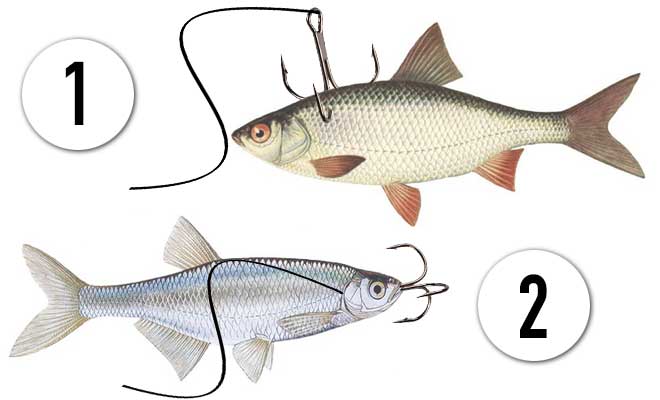
In order for live bait to retain its mobility for a long time, it must be correctly placed on the hook. If you use a double, the fish is hooked onto the dorsal fin. If you use a single hook, then it is threaded through the gills. But in this case you need to be careful not to damage the gills, otherwise the baitfish will quickly die.
Catching pike perch on zherlitsy in winter: choosing a place
Favorite stopping places for pike perch:
- bottom rifts;
- oxbows;
- quiet ponds;
- clean rivers.
It is unlikely that the fish will leave their homes in the reservoir if conditions have not changed much since the summer.
In winter, flocks usually appear in the same place and on certain days. For fishermen, having even a little experience, it is not difficult to decide on tactics and placement of girders in the right places, if the reservoir is at least a little familiar or well chosen.
Of course, it is difficult for beginners to decide on a good place.
Experienced fishermen advise choosing:
- bottom rifts, depressions;
- coastal edges;
- deepened pits.
The girders need to be placed across the lines, mainly in the evening. At night, check more often using fireflies. You need to drill holes not straight, but in the form of a curved line, gradually turning the drilling device to the side.
This approach will help to conduct a search of a nearby area and quickly identify the location of the pike perch.
Drilling holes with a bend is a visually effective option for easy inspection of holes and monitoring bites, if, for example, a fisherman is sitting nearby at another hole at the same time.
But if the fish does not want to bite for more than 2 hours in a row, then it is likely that there is simply no fish in this place and it is probably time to move the girders to other, more promising places.
REFERENCE! Often pike perch looks for food in the bottom layers, about 20-25 cm from the bottom. These are catchy places and the main thing is not to miss the bite. This is important especially at night, when fishermen lose their vigilance. An approaching fish can quickly and imperceptibly pull the bait off the hook and get off. There is also a high probability of gear breaking, snagging on snags, and bait bait becoming entangled in the gear.
Snags are the preferred interior for pike perch, but difficult for beginners and those unfamiliar with the area. If you managed to visit a reservoir for the first time and the bottom topography is unknown, it is wise to first tap the bottom to identify places with sharp depth changes. Why - move the sinker along the bottom of the reservoir.
The appearance of confident bites is the approach of a flock of pike perch, when it is no longer possible to hesitate and you need to act.
Choosing the time for catching pike perch on girders in winter
In winter, the fish begin to switch to a new diet and move to deeper parts of the reservoir.
Approximately when the water drops to -10 degrees, the pike perch begins to eat.
As soon as the ice gains strength and reaches a thickness of 7-10 cm, you can safely go fishing and drill into catchable places. Such conditions last in central Russia for about 1 month (approximately until mid-December).
If you decide to fish in the first ice (during the period of ice formation), then, of course, you need to know the area and fish where the fish were found in summer and autumn.
Pike-perch is not a fan of abruptly changing its usual locations throughout almost the entire fishing season. Usually lives in the same places.
At the beginning of winter it is:
- channel holes near the bottom;
- edges (edge) at the exit from the pits;
- steep relief fractures.
By the end of December, the pike perch’s zest noticeably decreases, because the oxygen regime in the reservoir is deteriorating. The predator at this time is well-fed and does not rush at the bait.
Flooding is possible - random, exclusively in the dark, when pike perch comes out in schools to feast on small fish up to 15 g (erkhovka, roach, bleak).
The note! It is better to catch a predator on a girder when the ice on the river has gained strength and will not be dangerous for the fisherman to escape. Even bad weather at this time is not a reason to give up fishing. This is one of the best periods in winter, when large specimens of pike perch are willing to go. But it is worth considering the depth of the rivers and the street temperature. Shallow bodies of water with standing water become covered with ice faster, and a little later – ponds and reservoirs with slow flows.
Pike perch is a crepuscular fish. It is active at night, when it is necessary to place fishing rods, checking for the presence of a catch in the morning. Although even at this time, bites may be false. The whole point is the timidity of the fish, which senses even minor rustles.
It happens that a pike perch catches the resistance of the fishing line, throws the bait out of its mouth and moves away. Sometimes it just tugs at the bait, then swims past. Such nuances are not uncommon when fishing with girders in winter. But knowledge will help fishermen avoid many mistakes.
The main thing is patience, vigilance and dexterity. It is extremely important to react in time when catching a pike perch.
Techniques for catching pike perch using girders
Of course, every experienced fisherman knows his own method of catching pike perch using girders. It’s more difficult for beginners, because each type of bait requires the choice of a specific fishing technique.
Basic techniques for zherlits:
- Maintain pauses without loosening the line if the pike perch provides strong resistance
- Play with a predator without slowing down the pace of fishing
- Install the girders at a distance of 15 cm from each other , not far from the holes and edges, having previously examined the bottom of the reservoir. Finding good places is not easy. Often fishermen have to work hard for this.
- Do not go far from the girders to avoid missing bites, especially in the middle of winter in the morning - from 5 to 10 o'clock, or in the evening - from 16 to 20 o'clock.
- Carry out hooking only after the line has been completely unwound.
- Install the girders correctly so that they actually work on time when catching pike perch.
One of the techniques for catching pike perch:
- Equip the tackle with live bait;
- Place the reel in the water;
- Pull the line so that the load remains in a free hanging position and does not touch the bottom;
- Secure the coil with a flag.
If the water in the river is stagnant, then the procedure for installing the girder will be slightly different:
- move the weight as close to the hook as possible;
- lower the tackle to the bottom so that the line is about 30-35 cm in the water;
- fix the coil;
- lightly pull the rig out of the water;
- equip the hook with fry;
- put in water;
- expect bites.
Biting, hooking and fishing
Bites will be indicated by lit beacon flags, which are usually placed by fishermen in the process of catching pike perch on girders.
- Hooks should be energetic , however, you cannot rush to the gear immediately and fish it out.
- You need to approach the holes quietly , waiting until the line stops coming off the reel. It is at this moment that the pike perch usually swallows live bait, so it is necessary to pause for 20-30 seconds, let the predator swallow the bait in full, and only after that the tackle begins to take out the hook.
- When you feel excellent and powerful resistance on the line , you need to start catching fish, but without fuss, otherwise you can quickly lose your gear if the fish breaks or disappears.
- You need to pull the pike perch towards you smoothly. Make sure that the line does not sag. It is important to pause between bites without loosening the line.
- Even if the fish begins to show strong resistance , you should not rush, but it is better to wait another 2 minutes and only then start hooking.
- If a predator is introduced into a hole, the pace of fishing cannot be reduced. You need to immediately hook it with a curved hook (hand) to the upper part of the body after the pike perch enters the hole.
A hungry pike perch will swallow the bait immediately and along with the hook. If full, it may hesitantly grab the bait, but then let go. When biting, you can’t rush. The goal is to prevent the fish from coming to its senses and moving away from the hole. It is worth waiting 30 seconds and then hooking, fishing evenly and actively.
How to catch
Fishing tactics in winter are carried out according to the following scheme:
- drill about 10 holes;
- fish the holes, lowering the bait 25-50 cm from the bottom (depending on the current);
- use a retractable leash to attract the attention of fish.
But the technique of fishing with a fishing rod, jig, girders and hookers will be somewhat different.
How to fish with baits and girders
It is necessary to install the tackle correctly:
- place the sprat on the hook;
- lower the reel until the load touches the bottom;
- pull the line, raising the bait by 20-30 cm;
- fix the reel with a flag at the vent or tie the spacer to the coastal vegetation.
When a bite occurs, you need to wait about 30 seconds for the pike perch to swallow the bait, then hook. Quickly pull out the tackle, reload and lower it into the water. As long as a school of predators stays nearby, you can catch several fish in a row.
Video: how to make supplies for catching pike perch
How to fish with a rod and jig
Catching tactics for fishing rod and jig are as follows:
- the bait is lowered to the bottom;
- make a sharp jerk, lifting the bait;
- alternate jerks with pauses of up to 15-20 seconds.
If you are fishing in a body of water with standing water, then you should fish different horizons.
Specifics of catching pike perch on zherlitsa in winter
You need to fish for pike perch in winter only after the ice on the river really becomes safe and strong.
Fishing with girders is effective almost throughout the winter and right up to the melting of the glaciers. But when the water current is strong, it is not recommended to go out and fish, because bites at this time are unlikely.
- When fishing for pike perch, it is important to take into account the characteristics of the reservoir and the terrain and weather conditions.
- Water freezes faster in small rivers and reservoirs , where it is appropriate to set up girders and go hunting at night.
- You should be prepared for the fact that you cannot avoid a break or snags in the fishing line. But it happens that pike perch swims by and only slightly twitches the bait.
- At the beginning of winter, the predator can be found in wider areas of the reservoir. Although the fish shows the highest activity where it is used to, i.e. lived in the summer.
- Pike-perch is not picky and will not be too picky about the bait. At the beginning of winter it attacks any live bait. But closer to the wilderness it becomes well-fed, which means it becomes more selective.
Where to find pike perch
In winter, it is not so easy to find the place where this predator lives.
If fishing is carried out on the Volga or another large river, you can catch a specimen weighing up to 10 kg. This fish does not go into suspended animation, remaining active even in the most severe frosts, when the ice reaches a serious thickness.
The predator likes to hide in one of these secluded places:
- depth changes;
- eyebrows;
- pits;
- stone rubble;
- hills and areas with shallow depths during the cold period;
- a large number of driftwood.
Fishing for pike perch using sprat will be especially successful in parts of the reservoir with a rocky or hard sandy bottom, as well as in clean water without silt.
At different times of the year, the search for pike perch is carried out differently. For example, in the summer it will be enough for you to know the topography of the reservoir well, as well as the existing snags. Then you can easily find a school of this fish. But in winter you will have to run around, since you will not be looking for a place, but specifically for fish.
If you just sit near the feeding hole and wait for prey, then you can forget about the catch. In winter, when there is much less food, the flock will look for food for itself, and you will look for it. During this period, pike perch is constantly on the move. One thing is reassuring that the flock’s route basically does not change. Therefore, if you are already quite familiar with its feeding areas, you need to walk through these areas.
As a result, you will definitely stumble upon it. But pike perch don't always behave this way. There are some schools that freeze in winter in one place at the very bottom, and they are not interested in either food or bait. It is practically impossible to catch such a pike perch, because it has fallen into suspended animation and very rarely bites.
Typical mistakes when catching pike perch on girders in winter
Not only beginners, but also experienced fishermen make mistakes when catching pike perch using girders. Catching a predator requires working out all the nuances and small moments.
The most popular mistakes:
- Bites need to be monitored extremely carefully , since they often occur so quickly that the fisherman simply does not have time to react and run to the hole, especially in the case of placement over long distances.
- It is not recommended to place vents more than 10 m from each other.
- Hooking should be done after the fishing line has completely unwound.
- You can’t hesitate to hook if the fish starts to bite, otherwise you can quickly lose your bait or the pike perch can get tangled in the gear.
- It is necessary to drill several holes up to - 8-10 , since 1-2 are unlikely to be effective.
- to conduct a raid on an impressive part of the reservoir.
- It is unwise to install girders in snags , because in the event of snags, a fisherman can miss a whole school of fish and lose his gear.
- Bites from pike perch can be so rapid that the trap is triggered, and the fisherman does not have time to run up to the fishing spot. At this time, the pike perch can spit out the bait and swim away.
- It is important that at least 30 m of fishing line is wound on the reel to avoid sharp resistance from the pike perch.
- In the dead of winter, fishermen should not go far from the girders , so that all efforts do not ultimately become futile.
